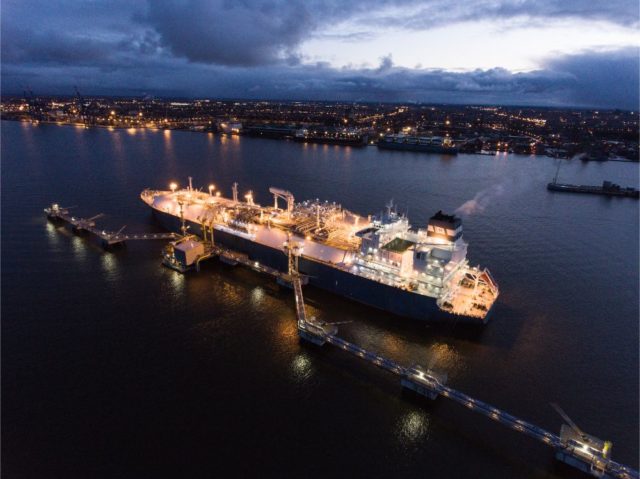
Baltic States Bet on New LNG Regasification Capacities
Publication: Eurasia Daily Monitor Volume: 19 Issue: 60
By:

On April 19, the Latvian Economy Minister Jānis Vitenbergs announced his government’s decision to support entirely abandoning natural gas supplies from Russia by the end of 2022 (Em.gov.lv, April 19). The strategy in that regard relies on expanding liquefied natural gas (LNG) regasification capacity across the region—that is, both domestically in Latvia and in neighboring Estonia, Finland as well as, possibly, Lithuania. If everything goes as planned, the Baltic States (Latvia, Lithuania, Estonia) should in the coming years have not one but as many as three LNG import terminals, significantly increasing their security of supply.
At present, the only LNG regasification terminal in the Baltic States is the floating storage and regasification unit (FSRU) Independence, moored in Klaipeda, Lithuania. The vessel is being leased by the Lithuanians since 2014; and recently, Vilnius approved its full acquisition at the end of the lease agreement, in 2024 (Kn.lt, February 25). Independence has a technical regasification capacity of 3.75 billion cubic meters (bcm) per year, which is currently being used to the maximum extent possible (the utilization rate during the gas year 2022 will be around 55 percent, based on the capacities bookings—the “real” regasification capacity is limited due to the logistics constraints regarding the acceptance and unloading of LNG tankers). However, according to the Lithuanian FSRU’s operator, Klaipedos Nafta, the company is currently working on how to further optimize the procedures to receive more LNG cargos, and it is examining the possibility of boosting (in the long term) the vessel’s technical regasification capacity to as much as 5 bcm (Kn.lt, March 17).
Based on the available data, the total gas consumption in the Baltic States amounts to approximately 4 bcm per year (Ambergrid.lt, January 21, 2022; Conexus.lv, July 2021; News.err.ee, April 7, 2022). This means that even when utilized to its maximum technical capacity, the Klaipeda LNG Terminal is currently slightly inadequate to meet the total demand in the region. Moreover, the Baltic States’ collective market is interconnected with Finland (which has no other full-fledged option to import non-Russian gas) and Poland (which is to start gas imports via Klaipeda in May 2022—Polskie Radio, March 24). To add some urgency to the situation, on Wednesday, April 26, Gazprom informed the Polish side that it was cutting off further gas supplies to Poland (Money.pl, April 26). As such, the Baltic States clearly require additional regasification capacities to secure stable gas supplies of non-Russian gas to the whole region. Hence, new LNG terminals projects are being developed in Estonia/Finland (joint undertaking) and in Latvia.
Of the two, the more advanced is the Estonian-Finnish project, intended to start operating its FSRU as soon as the winter 2022/2023. Preparatory works were likely started even before the Russian full-scale assault on Ukraine in February 2022. And in March–April, both countries’ governments confirmed their decisions to proceed with investment (Valitsus.ee, March 31; Valtioneuvosto.fi, April 7). The project includes leasing an FSRU (no details so far on who will be the ship owner and what the regasification capacity of the vessel might be) and mooring it either in southern Finland or in the port of Paldiski, Estonia. According to official statements, the company that will operate the terminal is to be controlled by the Finnish state, while Estonia will join as a minority partner (Valtioneuvosto.fi, April 7). Moreover, most recently, Latvian officials declared their country would also be willing to join the consortium, taking up roughly a 30 percent stake in the terminal (ERR, April 21).
In contrast, Latvia’s own LNG import terminal project is much less advanced. The Latvian government only recently announced that it will work on it. For now, Riga pledged to provide a cost assessment of available options by early June (Em.gov.lv, April 19). However, some local politicians already expect that the facility will turn out to be much more economically competitive than the LNG terminals in neighboring countries (Lsm.lv, April 20). The main argument in favor of such an estimation is that Latvians will be able to monetize the synergies between LNG imports and the vast gas storage capacities already located in the country. The latter includes, namely, the Inčukalns Underground Gas Storage, with a current capacity of 2.3 bcm that can be further extended.
If the above-mentioned plans turn into reality, then the new LNG import facilities in the Baltic States promise to have a positive impact on the natural gas market throughout the broader region, including in Central and Eastern Europe. For instance, more Baltic regasification capacities should add to the security of supply of Poland, as the country is using its LNG terminal (in Świnoujście) at the highest possible utilization rate already, and total demand in the region is only forecasted to grow. Even if the current capacity of the Lithuania-Poland gas interconnector (GIPL) is rather limited (around 2 bcm per year), it nonetheless should help to ease the projected tightness of the market at least in the coming years.



